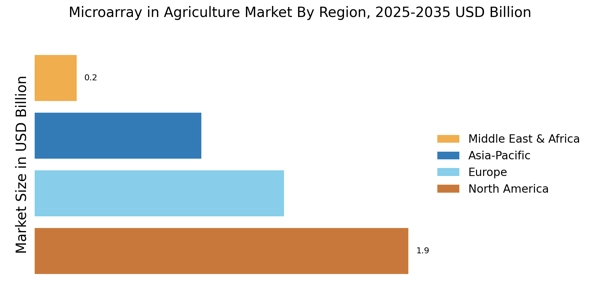The Microarray in Agriculture Market is currently characterized by a dynamic competitive landscape, driven by technological advancements and increasing demand for precision agriculture. Key players such as Agilent Technologies (US), Thermo Fisher Scientific (US), and Illumina (US) are at the forefront, leveraging their extensive research capabilities and innovative product offerings. Agilent Technologies (US) focuses on enhancing its microarray platforms to support agricultural genomics, while Thermo Fisher Scientific (US) emphasizes partnerships with agricultural research institutions to expand its market reach. Illumina (US) is strategically investing in next-generation sequencing technologies, which complement microarray applications, thereby positioning itself as a leader in agricultural biotechnology. Collectively, these strategies foster a competitive environment that prioritizes innovation and collaboration, essential for addressing the evolving needs of the agriculture sector.
In terms of business tactics, companies are increasingly localizing manufacturing and optimizing supply chains to enhance operational efficiency. The Microarray in Agriculture Market appears moderately fragmented, with several players vying for market share. However, the influence of major companies is substantial, as they set industry standards and drive technological advancements. This competitive structure suggests that while smaller firms may offer niche solutions, the larger entities dominate through economies of scale and extensive distribution networks.
In August 2025, Agilent Technologies (US) announced a collaboration with a leading agricultural university to develop advanced microarray solutions tailored for crop improvement. This partnership is significant as it not only enhances Agilent's product portfolio but also strengthens its ties with academic research, potentially leading to groundbreaking innovations in crop genetics. Such collaborations are likely to accelerate the adoption of microarray technologies in agriculture, thereby expanding market opportunities.
In September 2025, Thermo Fisher Scientific (US) launched a new line of microarray kits specifically designed for soil health assessment. This strategic move reflects the growing emphasis on sustainable agriculture practices. By providing tools that enable farmers to monitor soil conditions, Thermo Fisher is positioning itself as a key player in the sustainability movement within agriculture, which is increasingly becoming a focal point for stakeholders in the industry.
In October 2025, Illumina (US) unveiled a new software platform that integrates AI capabilities with its microarray technologies, aimed at enhancing data analysis for agricultural applications. This development is crucial as it signifies a shift towards data-driven decision-making in agriculture, allowing for more precise and efficient farming practices. The integration of AI not only improves the functionality of microarrays but also aligns with the broader trend of digital transformation in the agricultural sector.
As of October 2025, the competitive trends in the Microarray in Agriculture Market are increasingly defined by digitalization, sustainability, and the integration of artificial intelligence. Strategic alliances among key players are shaping the landscape, fostering innovation and enhancing product offerings. Looking ahead, it is anticipated that competitive differentiation will evolve, with a pronounced shift from price-based competition to a focus on technological innovation, supply chain reliability, and sustainable practices. This evolution underscores the necessity for companies to adapt and innovate continuously to maintain their competitive edge in a rapidly changing market.


















Leave a Comment